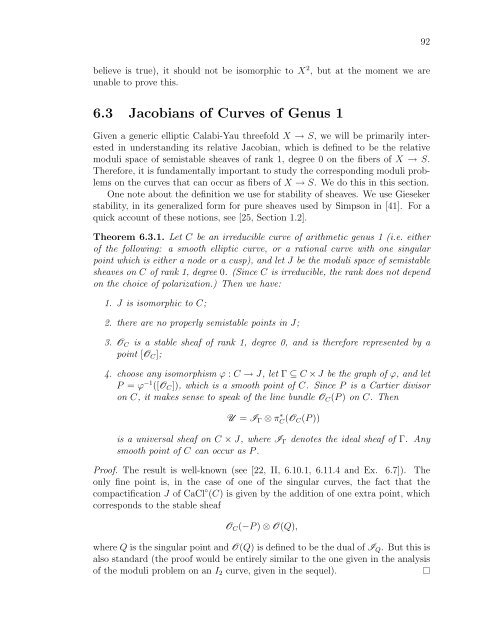derived categories of twisted sheaves on calabi-yau manifolds
derived categories of twisted sheaves on calabi-yau manifolds
derived categories of twisted sheaves on calabi-yau manifolds
Create successful ePaper yourself
Turn your PDF publications into a flip-book with our unique Google optimized e-Paper software.
elieve is true), it should not be isomorphic to X 2 , but at the moment we are<br />
unable to prove this.<br />
6.3 Jacobians <str<strong>on</strong>g>of</str<strong>on</strong>g> Curves <str<strong>on</strong>g>of</str<strong>on</strong>g> Genus 1<br />
Given a generic elliptic Calabi-Yau threefold X → S, we will be primarily interested<br />
in understanding its relative Jacobian, which is defined to be the relative<br />
moduli space <str<strong>on</strong>g>of</str<strong>on</strong>g> semistable <str<strong>on</strong>g>sheaves</str<strong>on</strong>g> <str<strong>on</strong>g>of</str<strong>on</strong>g> rank 1, degree 0 <strong>on</strong> the fibers <str<strong>on</strong>g>of</str<strong>on</strong>g> X → S.<br />
Therefore, it is fundamentally important to study the corresp<strong>on</strong>ding moduli problems<br />
<strong>on</strong> the curves that can occur as fibers <str<strong>on</strong>g>of</str<strong>on</strong>g> X → S. We do this in this secti<strong>on</strong>.<br />
One note about the definiti<strong>on</strong> we use for stability <str<strong>on</strong>g>of</str<strong>on</strong>g> <str<strong>on</strong>g>sheaves</str<strong>on</strong>g>. We use Gieseker<br />
stability, in its generalized form for pure <str<strong>on</strong>g>sheaves</str<strong>on</strong>g> used by Simps<strong>on</strong> in [41]. For a<br />
quick account <str<strong>on</strong>g>of</str<strong>on</strong>g> these noti<strong>on</strong>s, see [25, Secti<strong>on</strong> 1.2].<br />
Theorem 6.3.1. Let C be an irreducible curve <str<strong>on</strong>g>of</str<strong>on</strong>g> arithmetic genus 1 (i.e. either<br />
<str<strong>on</strong>g>of</str<strong>on</strong>g> the following: a smooth elliptic curve, or a rati<strong>on</strong>al curve with <strong>on</strong>e singular<br />
point which is either a node or a cusp), and let J be the moduli space <str<strong>on</strong>g>of</str<strong>on</strong>g> semistable<br />
<str<strong>on</strong>g>sheaves</str<strong>on</strong>g> <strong>on</strong> C <str<strong>on</strong>g>of</str<strong>on</strong>g> rank 1, degree 0. (Since C is irreducible, the rank does not depend<br />
<strong>on</strong> the choice <str<strong>on</strong>g>of</str<strong>on</strong>g> polarizati<strong>on</strong>.) Then we have:<br />
1. J is isomorphic to C;<br />
2. there are no properly semistable points in J;<br />
3. OC is a stable sheaf <str<strong>on</strong>g>of</str<strong>on</strong>g> rank 1, degree 0, and is therefore represented by a<br />
point [OC];<br />
4. choose any isomorphism ϕ : C → J, let Γ ⊆ C × J be the graph <str<strong>on</strong>g>of</str<strong>on</strong>g> ϕ, and let<br />
P = ϕ −1 ([OC]), which is a smooth point <str<strong>on</strong>g>of</str<strong>on</strong>g> C. Since P is a Cartier divisor<br />
<strong>on</strong> C, it makes sense to speak <str<strong>on</strong>g>of</str<strong>on</strong>g> the line bundle OC(P ) <strong>on</strong> C. Then<br />
U = IΓ ⊗ π ∗ C(OC(P ))<br />
is a universal sheaf <strong>on</strong> C × J, where IΓ denotes the ideal sheaf <str<strong>on</strong>g>of</str<strong>on</strong>g> Γ. Any<br />
smooth point <str<strong>on</strong>g>of</str<strong>on</strong>g> C can occur as P .<br />
Pro<str<strong>on</strong>g>of</str<strong>on</strong>g>. The result is well-known (see [22, II, 6.10.1, 6.11.4 and Ex. 6.7]). The<br />
<strong>on</strong>ly fine point is, in the case <str<strong>on</strong>g>of</str<strong>on</strong>g> <strong>on</strong>e <str<strong>on</strong>g>of</str<strong>on</strong>g> the singular curves, the fact that the<br />
compactificati<strong>on</strong> J <str<strong>on</strong>g>of</str<strong>on</strong>g> CaCl ◦ (C) is given by the additi<strong>on</strong> <str<strong>on</strong>g>of</str<strong>on</strong>g> <strong>on</strong>e extra point, which<br />
corresp<strong>on</strong>ds to the stable sheaf<br />
OC(−P ) ⊗ O(Q),<br />
where Q is the singular point and O(Q) is defined to be the dual <str<strong>on</strong>g>of</str<strong>on</strong>g> IQ. But this is<br />
also standard (the pro<str<strong>on</strong>g>of</str<strong>on</strong>g> would be entirely similar to the <strong>on</strong>e given in the analysis<br />
<str<strong>on</strong>g>of</str<strong>on</strong>g> the moduli problem <strong>on</strong> an I2 curve, given in the sequel).<br />
92
















